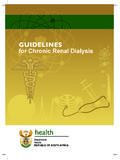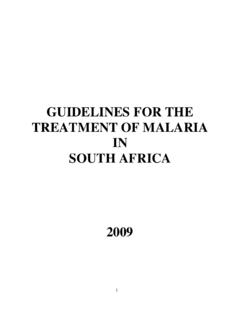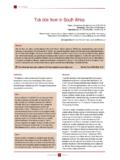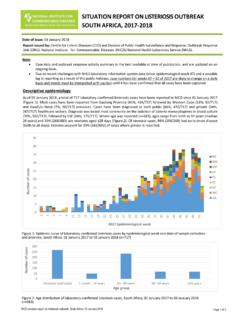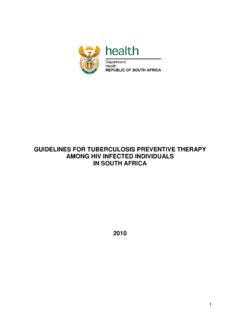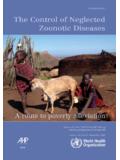Transcription of NATIONAL HEALTH INSURANCE IN SOUTH AFRICA - PPS
1 1 EMBARGOED UNTIL 5h00 FRIDAY 12 AUGUST NATIONAL HEALTH INSURANCE IN SOUTH AFRICA POLICY PAPER 2 Contents 1. INTRODUCTION .. 4 2. PROBLEM STATEMENT .. 5 THE BURDEN OF DISEASE IN SOUTH AFRICA .. 7 HIV/AIDS and TB .. 7 Maternal, Child and Infant Mortality .. 8 Non-Communicable Diseases .. 8 Injury and Violence .. 8 QUALITY OF HEALTHCARE .. 9 HEALTHCARE EXPENDITURE IN SOUTH AFRICA .. 9 DISTRIBUTION OF FINANCIAL AND HUMAN RESOURCES .. 10 MEDICAL SCHEMES INDUSTRY .. 11 3. HISTORY OF PROPOSALS ON HEALTHCARE FINANCING REFORM IN SOUTH AFRICA .. 12 Commission on Old Age Pension and NATIONAL INSURANCE (1928) .. 12 Committee of Enquiry into NATIONAL HEALTH INSURANCE (1935) .. 12 NATIONAL HEALTH Service Commission (1942 1944) .. 13 HEALTH Care Finance Committee (1994).
2 13 Committee of Inquiry on NATIONAL HEALTH INSURANCE (1995) .. 14 The Social HEALTH INSURANCE Working Group (1997) .. 14 Committee of Inquiry into a Comprehensive Social Security for SOUTH AFRICA (2002) .. 14 Advisory Committee on NATIONAL HEALTH INSURANCE (2009) .. 15 4. NATIONAL HEALTH INSURANCE .. 15 5. PRINCIPLES OF NATIONAL HEALTH INSURANCE IN SOUTH AFRICA .. 16 6. OBJECTIVES OF NATIONAL HEALTH 18 7. SOCIOECONOMIC BENEFITS OF NATIONAL HEALTH INSURANCE .. 19 Economic Impact Modelling .. 21 8. THE THREE DIMENSIONS OF UNIVERSAL COVERAGE .. 21 9. POPULATION COVERAGE UNDER NATIONAL HEALTH INSURANCE .. 23 10. THE RE-ENGINEERED PRIMARY HEALTH CARE SYSTEM .. 23 District Clinical Specialist Support Teams .. 24 3 School HEALTH Services .. 25 Municipal Ward-based Primary HEALTH Care Agents.
3 26 11. HEALTHCARE BENEFITS UNDER NATIONAL HEALTH INSURANCE .. 26 The Service Package within the Context of District Heath Services .. 27 Delivery of Primary HEALTH Care Services through Private Providers .. 28 Hospital-Based Benefits .. 28 Designation of Hospitals .. 29 12. ACCREDITATION OF PROVIDERS OF HEALTH CARE SERVICES .. 31 Office of HEALTH Standards Compliance .. 31 Accreditation Standards .. 32 13. PAYMENT OF PROVIDERS UNDER NATIONAL HEALTH INSURANCE .. 32 HEALTHCARE CODING SYSTEMS AND REIMBURSEMENT .. 33 UNIT OF CONTRACTING PROVIDERS OF HEALTH CARE SERVICES .. 34 14. PRINCIPAL FUNDING MECHANISMS FOR NATIONAL HEALTH INSURANCE .. 35 The Role of Co-Payments under NATIONAL HEALTH INSURANCE .. 35 15. HOW MUCH WILL NATIONAL HEALTH INSURANCE COST.
4 36 Funding Flows .. 41 16. THE ESTABLISHMENT OF THE NATIONAL HEALTH INSURANCE 41 17. THE ROLE OF MEDICAL SCHEMES .. 43 18. REGISTRATION OF THE POPULATION .. 43 19. INFORMATION SYSTEMS FOR NATIONAL HEALTH INSURANCE .. 44 20. MIGRATION FROM THE CURRENT HEALTH SYSTEM INTO THE NATIONAL HEALTH INSURANCE ENVIRONMENT .. 44 21. PILOTING OF NATIONAL HEALTH INSURANCE .. 52 BIBILOGRAPHY .. 53 4 1. INTRODUCTION 1. SOUTH AFRICA is in the process of introducing an innovative system of healthcare financing with far reaching consequences on the HEALTH of SOUTH Africans. The NATIONAL HEALTH INSURANCE commonly referred to as NHI will ensure that everyone has access to appropriate, efficient and quality HEALTH services. It will be phased-in over a period of 14 years.
5 This will entail major changes in the service delivery structures, administrative and management systems. 2. The NHI is intended to bring about reform that will improve service provision. It will promote equity and efficiency so as to ensure that all SOUTH Africans have access to affordable, quality healthcare services regardless of their socio-economic status. 3. The current system of healthcare financing in SOUTH AFRICA is two-tiered, with a relatively large proportion of funding allocated through medical schemes, various hospital care plans and out of pocket payments. This current funding arrangement provides cover to private patients who have purchased a benefit option with a scheme of their choice or as a result of their employment conditions.
6 It only benefits those who are employed and are subsidised by their employers both the State and the private sector. The other portion is funded through the fiscus and is mainly for public sector users. This means that those with medical scheme cover have a choice of providers operating in the private sector which is not extended to the rest of the population. 4. A larger part of the financial and human resources for HEALTH is located in the private HEALTH sector serving a minority of the population. Medical schemes are the major purchasers of services in the private sector which covers of the population (CMS1, 2009). The public sector is under-resourced relative to the size of the population that it serves and the burden of disease.
7 The public sector has disproportionately less human resources than the private sector yet it has to manage significantly higher patient numbers. 1 CMS: Council for Medical Schemes is a statutory body with regulatory oversight for the medical scheme s industry. It is established by an Act of Parliament, the Medical Schemes Act, 1998 5 5. The SOUTH African HEALTH system is inequitable, with the privileged few having disproportionate access to HEALTH services. There is recognition that this system is neither rational nor fair. Therefore, NHI is intended to ensure that all SOUTH African citizens and legal residents will benefit from healthcare financing on an equitable and sustainable basis.
8 NHI will provide coverage to the whole population and minimise the burden carried by individuals of paying directly out of pocket for healthcare services. This model of delivering HEALTH and healthcare services to the population is well accepted, described and widely promoted by the World HEALTH Organisation as universal coverage. 6. To successfully implement a healthcare financing mechanism that covers the whole population such as NHI, four key interventions need to happen simultaneously: i) a complete transformation of healthcare service provision and delivery; ii) the total overhaul of the entire healthcare system iii) the radical change of administration and management iv) the provision of a comprehensive package of care underpinned by a re-engineered Primary HEALTH Care.
9 2. PROBLEM STATEMENT 7. Prior to the 1994 democratic breakthrough, SOUTH AFRICA had a fragmented HEALTH system designed along racial lines. One system was highly resourced and benefitted the white minority. The other was systematically under-resourced and was for the black majority. The Constitution has outlawed any form of racial discrimination and guarantees the principles of socioeconomic rights including the right to HEALTH . 8. Attempts to deal with these disparities and to integrate the fragmented services that resulted from fourteen HEALTH departments (serving the four race groups, including the ten Bantustans) did not fully address the inequities. Problems linked to HEALTH financing that are biased towards the privileged few have not been adequately addressed.
10 9. Post 1994 attempts to transform the healthcare system and introduce healthcare financing reforms were thwarted. This has entrenched a two-tiered HEALTH system, public and private, based on socioeconomic status and it continues to perpetuate inequalities in 6 the current HEALTH system. Attempts to reform the HEALTH system have not gone far enough to extend coverage to bring about equity in healthcare. 10. The two-tiered system of healthcare did not and still does not embrace the principles of equity and access and the current HEALTH financing mode does not facilitate the attainment of these noble goals. 11. The 2008 World HEALTH Report of the World HEALTH Organisation (WHO) details three trends that undermine the improvement of HEALTH outcomes globally, namely: Hospital centrism, which has a strong curative focus Fragmentation in approach which may be related to programmes or service delivery, and Uncontrolled commercialism2 which undermines principles of HEALTH as a public good 12.




